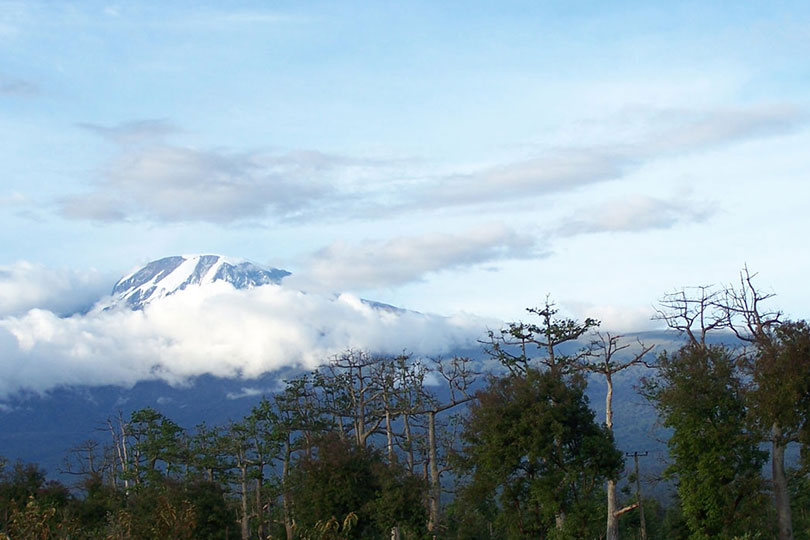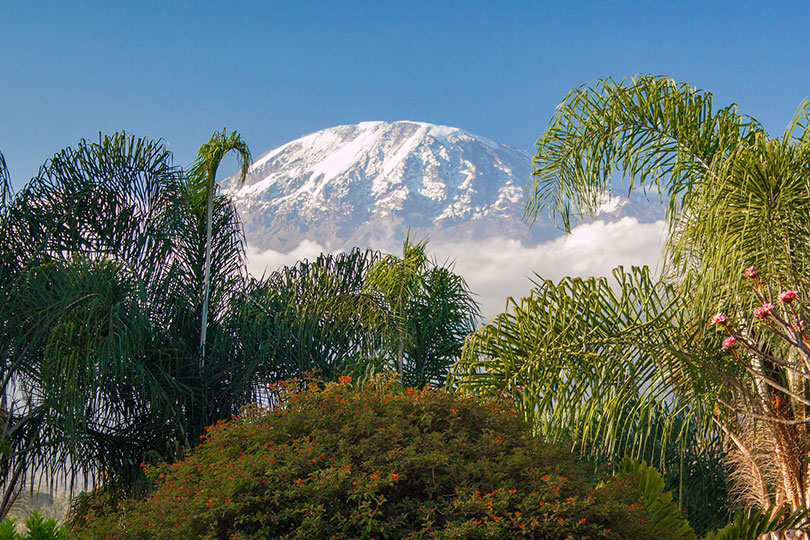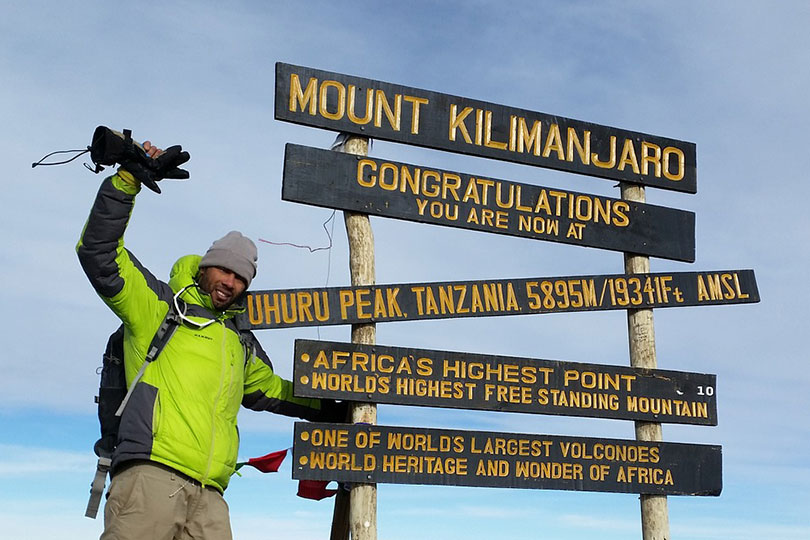Experience the enchanting trekking trail of Mt. Kilimanjaro, adorned with pristine wildlife and offering awe-inspiring panoramic views. Africa’s prominent peak is famous for its topographical diversity, with snow-capped mountains towering over the savannah. This famous African peak has a lot to offer in all seasons, but there is a specific best season to climb the Uhuru Peak. The best time to climb Kilimanjaro is during the months of late June to October and from December to February.
Outspokenly, the trekking trail of Kilimanjaro is an incredible challenge, even for an enthusiastic traveler. Different routes and tracks while ascending Africa’s highest mountain takes you over grasslands, tropical rain forests, alpine meadows, desert, moorlands, and snow. The weather conditions at Mt. Kilimanjaro differ throughout different seasons.
Himalayan Glacier also offers a combination package of Kilimanjaro climb and Luxury Safari in Tanzania, a trip filled with picturesque landscape, pristine wilderness, and a unique and remote Tanzania’s lifestyle.

Not just that, you will also pass through the desert, moorlands, and snow. And a chance to behold the remote and culturally rich lifestyle of Tanzania. For example, the Kilimanjaro Lemosho Route has stunning landscapes throughout the trail and the path of the Rongai Route passes through the remote areas of Tanzania.
The Kilimanjaro Machame Route has terrains and stunning vistas while Marangu has breathtaking views of Mawenzi and Kibo Peaks. Watch out for some features of these climate zones.
The table below gives you a general view of the weather condition, and the crowd on Mt. Kilimanjaro climb in different months.
| Month | Weather | Cloudiness | Crowd | Recommendation |
|---|---|---|---|---|
| January | Warm | Low | High | Highly Recommended |
| February | Warm | Low | High | Highly Recommended |
| March | Moderate | Medium | Low | Can Consider |
| April | Moderate | High | Low | Not Recommended |
| May | Moderate | High | Low | Not Recommended |
| June | Cold | Medium | Medium | Recommended |
| July | Cold | Low | High | Highly Recommended |
| August | Cold | Low | High | Highly Recommended |
| September | Moderate | Low | High | Highly Recommended |
| October | Moderate | Medium | Medium | Highly Recommended |
| November | Moderate | Medium | Low | Not Recommended |
| December | Moderate | Medium | Medium | Recommended |
- Climate Zones of Kilimanjaro
- Packing for each climate zone
- Best time of year to climb Kilimanjaro
- Climbing Kilimanjaro in January and February
- Climbing Mt Kilimanjaro in March, April & May
- Climbing Kilimanjaro in June
- Kilimanjaro Climbing in July, August, September, and October
- Climbing Kilimanjaro in November and December
- Popular Full Moon Climb to Kilimanjaro
- High Season to Climb Mount Kilimanjaro
- Low Season for Mt. Kilimanjaro
- Kilimanjaro Trail and Safety Conditions
- Frequently Asked Questions
Climate Zones of Kilimanjaro
For every adventure lover, ascending Uhuru Peak is the most desirable thing to do. However, before the climb, you have to analyze the weather conditions on the mountain. In addition to that, the Kili region has a wide variety of climatic zones, which have entirely different climates from each other. An avid adventurer, before planning the trip, would definitely seek information regarding the best time of year to climb Kilimanjaro.
Rain Forest Zone – The first part of your journey to the top of Africa covers the rain forest. Climate is misty, and sometimes drizzling is common in this region. Various flora such as orchids, ferns, and fig and olive trees cover this area of Mount Kilimanjaro.
Alpine Zone – The alpine zone is dominated by an unfriendly upland desert climate. The sun shines with high temperatures during the daytime, but temperatures dip below freezing throughout the night.

High Alpine Zone – The alpine zone is dominated by an unfriendly upland desert climate. The sun shines with high temperatures during the daytime, but temperatures dip below freezing throughout the night.
Glacial Zone – The last zone is glacial, where the oxygen rate is half as much compared to the lower area of the African peak. It is not the kind of place you want to hang around for a long time.
Although Kili has a rainy climate, several months are suitable to climb or to trek. Moreover, we have presented the weather and climate scenario of different months to make it easy for you to choose the best time to climb Kilimanjaro.
Packing for each climate zone
When packing for a hike on Kilimanjaro, it’s important to consider the different climate zones you’ll be passing through. The mountain has five different climate zones, each with its own unique conditions and temperature range.
The tropical rainforest is hot and humid, and temperatures can reach up to 30ºC (86ºF). Lightweight, breathable clothing is recommended, as well as a rain jacket or poncho for unexpected rain showers. Insect repellent, sunscreen, and a wide-brimmed hat are also essential items to pack.
In the montane forest area, the temperatures are cooler than the tropical rainforest, usually between 10 to 15ºC (50-59ºF). A warm, waterproof jacket and gloves are recommended, as well as a fleece or insulated layer for extra warmth. Trekking poles are also helpful for navigating the steeper terrain in this zone.
The heather and moorland zone is characterized by high altitude, cold temperatures, and strong winds. It’s important to pack warm clothing, such as a down jacket, thermal layers, and a warm hat and gloves. Gaiters and a waterproof shell are also essential for protecting against the wind and wet conditions.
It’s important to note that it’s better to pack items that are versatile and can be used in multiple climates. It’s also essential to pack enough clothing and gear to keep you warm and dry, as well as enough food, water, and first aid supplies for the duration of your hike.
Best time of year to climb Kilimanjaro
The climb to Uhuru Peak is a once-in-a-lifetime experience that many people dream of. However, it’s important to choose the right time of year to tackle this challenging climb. The best time of year to climb Kilimanjaro is during the dry seasons of December to February and late June to October. These months offer clear skies and dry trails, making the climb easier and more enjoyable. Additionally, the temperatures during these months are much cooler, making it less strenuous on your body.
Another factor to consider when planning your climb is the crowds. Many people flock to Africa’s highest peak during the popular months of January and February, which can make the climb more crowded and less enjoyable. In general, these months are the best times to climb Kilimanjaro. To avoid the crowds, consider climbing during the shoulder seasons of March to May and November to December. These months offer similar weather conditions as the dry seasons and less people on the mountain, making for a more peaceful and enjoyable climb. Overall, the best time to climb Uhuru Peak is during the dry seasons, but the shoulder seasons are also a great option for those looking for a more peaceful climb.
Climbing Kilimanjaro in January and February
The best time to climb Kilimanjaro is undoubtedly during January and February. In this season, the weather conditions are best for the climb. You get to treat yourself to beautiful morning views of the astounding Tanzanian landscape and natural beauty. However, during the afternoon, there is always a high chance of rainfall.

Climbing Mt Kilimanjaro in March, April & May
At the end of March, the rainy season starts in these regions. It is a long rainy season, which lasts until May. This season is inconvenient for climbing due to heavy rainfall.
The weather of Kilimanjaro in this season will not allow you to behold the picturesque view of Tanzania. In addition, the trekking routes of Kilimanjaro climb will become more difficult due to the constant rainfall.
Climbing Kilimanjaro in June
The month of June is the transitional period. In this month, the rainy season transforms into a dry season, which brings drier weather. Moreover, in this season, you will see a clear, bright blue sky, but sometimes it does get cloudy as well.
Kilimanjaro Climbing in July, August, September, and October
In general, temperatures are cooler from July until late October and much humid than in previous months. You will feel more relaxed in your trekking journey as it passes through the paths of rainforest and moorland.
These months are prominent because the bright sunny sky and beautiful views of Africa’s unique topography will be your friend for the whole journey.
Climbing Kilimanjaro in November and December
November is the beginning of Tanzania’s short rainy season and goes until December. During these months, afternoon rain is common. This season is ideal for trekkers and hikers, who wish to see clear views after rain during the climb. Meanwhile, December is also a popular time to trek Mt Kilimanjaro.

Popular Full Moon Climb to Kilimanjaro
The Kili climb is famous during the full moon time. Many adventurers and nature lovers desire to make their trip during the best time to climb Kilimanjaro, and even better during full moon time. Traveling during full moon ejects bright moonlight that illuminates your destination with the glittering glacier. Journey during full moon unfolds astonishing views of Mount Kino with improved visibility.
Therefore, the majority of travelers love to climb the Tanzanian mountains during the full moon. And another meaningful reason for climbing Africa’s tallest mountain during the full moon is because of its glows that enhance the insights of the Kilimanjaro trekking passes, especially during your summit attempt.
High Season to Climb Mount Kilimanjaro
Since Uhuru Peak lies near the equatorial region, it does not experience extreme winter or summer. Instead, the area is dominated by dry and wet seasons. The high season to climb Kilimanjaro is generally from December to mid-March and mid-June until October end.
Advantages of High season
- The high seasons offer favorable weather conditions, perfect for trekking and hiking.
- These seasons offer the treat of beautiful views of Tanzania.
Disadvantages of High season
- The biggest disadvantage of high season is the crowd it brings. Naturally, the high season brings along many fellow travelers, and the region gets pretty crowded.
Low Season for Mt. Kilimanjaro
The low seasons for Mt. Kili climb are the long rainy seasons that span from March to early June. It is better to avoid these months unless you are an experienced hiker who has trekked in similar conditions.
Advantages of Low Season
- Because of the low season, the mountain region gets very few travelers. As a result, you get to enjoy your trip more peacefully.
- The wet season unveils a different beauty of the Arusha region, which is worth keeping an eye on.
Disadvantages of Low Season
- Because of the rain, the trail gets pretty wet and slippery. Therefore, you have to extra careful with your pace.
- These seasons offer low visibility due to heavy clouds.
Kilimanjaro Trail and Safety Conditions
Kilimanjaro is one of the most popular hiking destinations in the world, but it’s important to be aware of the safety concerns and trail conditions before embarking on your journey. The most important thing to consider is altitude sickness, which can occur when hikers ascend too quickly and their bodies are unable to acclimate to the thinning air. To mitigate the risk of altitude sickness, it’s recommended to take a gradual approach, allowing your body time to adjust, and to consult with your doctor before your trip.
The trail conditions on Kilimanjaro can vary depending on the time of year and the route you take. During the rainy seasons, the trails can become muddy and slippery, making the hike more challenging. Additionally, some routes may be closed due to snow or ice, so it’s essential to check for trail updates before your hike. It’s also important to note that the final ascent to the summit is a technical climb and requires proper equipment and experience. Hiring a guide or taking a guided tour can help ensure your safety and provide valuable information about the trail conditions.
Frequently Asked Questions
Which is the Best Route for Mt. Kilimanjaro?
One of the specialties of Kilimanjaro is the fact that it offers various routes for travelers. However, the best route to climb Mount Kilimanjaro is the Lemosho Route. This route offers the most beautiful scenic view and is also less crowded than the other routes. Further, it also has the best acclimatization, which increases your chance safe and successful ascent of the highest peak in Africa.
Apart from the Lemosho route, the Machame route is also a famous one. This route offers beautiful terrains and stunning vistas and is shorter than the Machame route. The other routes are the Rongai route, which passes through the remote areas of Tanzania, and the Marangu route, which has breathtaking views of Mawenzi and Kibo Peaks.
How Difficult Is Mt. Kilimanjaro Climb?
Naturally, if you are new to trekking, climbing Uhuru Peak will be a daunting task for you. However, it is not impossible, as the difficulty level is not extreme.
The biggest challenge is the altitude, but there are itineraries made with proper acclimatization points to tackle that. To get you into the bargain, many first-time travelers have successfully ascended Mt. Kili. Further, you also need to be physically fit, as the trip requires 6 – 7 hours long walks over the undulating ground for several days.
How Can You Prepare For Mt. Kilimanjaro Climb?
Mt. Kilimanjaro is physically challenging, but it’s not back-breaking. The trip doesn’t require specific mountaineering skills or technical expertise, but trekkers need to be physically fit and determined. An ‘I can do it!’ attitude is a must for this demanding trip.
To prepare for the climb, you can start basic physical activities a few weeks earlier. Some good options include going on short hikes, going to the gym, and running on tracks.
Climbing Mt. Kilimanjaro offers exceptional views of nature. This blog provides a general idea of the best time to trek around the world’s highest standing peak. If you’re planning to trek in this region, you’re welcome to talk to our experts who have helped numerous travelers explore the amazing beauty of the Kili trails.

Amedeus Cyril Maro is dedicated to his work as a trekking guide having good communication, interpretation and leadership skills. He is a great entertainer and has led trekkers from around the world to Mt. Kilimanjaro and Tanzania’s other peaks numerous times.






